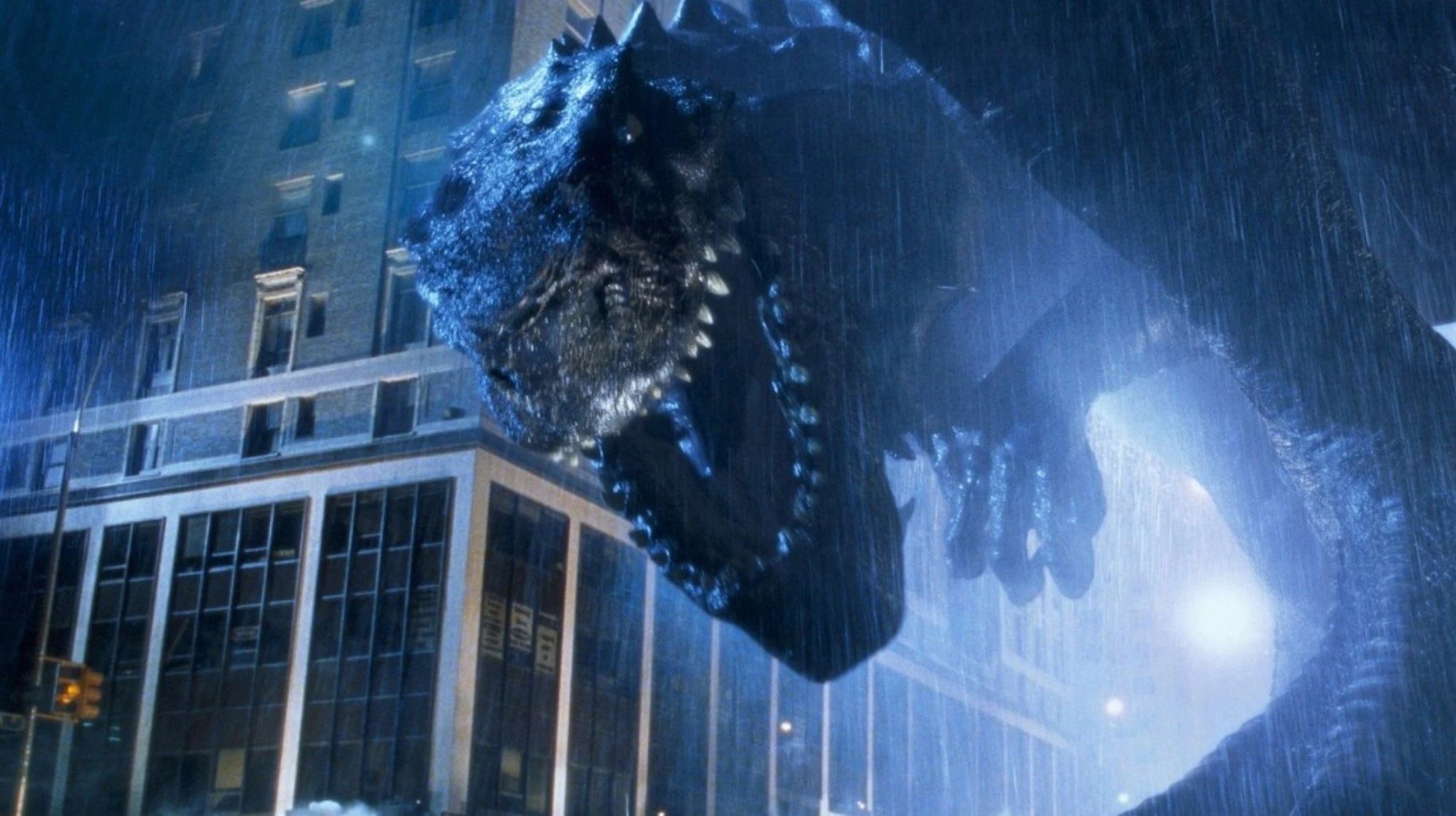
By Ben Dower
Nuclear weapons testing by France in the French Polynesia mutates a lizard into a giant fish-eating dinosaur-like monster, which migrates to New York City. Biologist Nick Tatopoulos (Matthew Broderick) is tasked with helping the U.S. military eradicate the creature. While in New York, he reconnects with his ex-girlfriend Audrey Timmonds (Maria Pitillo), who has been unsuccessful in her attempt to make it as a reporter, in part due to a horrible boss in news anchor Charles Caiman (Harry Shearer).
When Audrey steals classified information from Nick to try to boost her career, he is fired from his role with the military and abducted by French secret agent Philippe Roach? (Jean Reno). Nick, Philippe, Audrey, and cameraman Victor ?Animal? Palotti (Hank Azaria) eventually find the creature?s nest in Madison Square Garden, where around 200 eggs are starting to hatch…
Though attempts to adapt Godzilla for the big screen in America had initially begun in the early 1980s, Godzilla had already been adapted for the small screen in the United States. Hanna-Barbera, the animation studio behind The Flintstones (1960-1966) and Scooby Doo, Where Are You! (1969-1970) also produced Godzilla (1978-1979), a two-season animated series. The creature in the series differs a lot from Toho?s creation, and can be called by the crew of the ship called Calico whenever he is needed to save them.

In 1983, Steve Miner managed to get Toho?s approval to produce an American Godzilla film. With a script by Fred Dekker and art by William Stout, Miner pitched his vision of a big budget 3D Godzilla film around Hollywood, but unfortunately he was not able to get funding for his film.
TriStar Picture?s acquisition of the rights to Godzilla was announced in October 1992, but like Miner, the studio struggled to get their big budget American Godzilla movie off the ground. Terry Rossio and Ted Elliott were hired by the studio to write the new Godzilla film, and then Jan de Bont was hired to direct in 1994. Jan de Bont left the project later that year when the studio got concerned their big budget Godzilla film was becoming a little too big budget.
In 1996, the alien-invasion film Independence Day hit screens and was a huge success. Director Roland Emmerich and writer Dean Devlin had proved themselves capable of creating a successful large-scale scifi disaster epic, and that was exactly what TriStar Pictures wanted from their future Godzilla film. Emmerich and Devlin agreed to make the film, but demanded a wide latitude when it came to creative freedom.
Amid a huge marketing campaign, the film was released on May 20th, 1998 for the Memorial Day weekend and was met with instant rejection from Godzilla fans and negative reviews by critics. So where did Emmerich and Devlin?s Godzilla go wrong?

To be honest, the first portion of the film is pretty good.??The movie opens with stock footage of real nuclear tests, and then turns into a bit of a mystery as the characters try to piece together the cause of a series of unusual events.??Finally, the creature arrives in New York City, but the audience is denied a good look at it, instead catching glimpses from the point of view of the people on the ground and in the buildings.??All great suspense-building sequences and totally expected in a giant monster movie.
After Godzilla?s arrival in New York, however, it quickly becomes obvious that the creature on screen is not much like the Toho Godzilla fans know and love. The character has been heavily redesigned to match more up-to-date reconstructions of therapod dinosaurs, despite only being a mutated lizard, and looks almost nothing like the original Godzilla. Behaviourally, it is capable of running fast, cowardly flees when attacked, tends to burrow underground, lays hundreds of eggs, and lacks the ability to breath atomic fire ? all huge departures from Toho?s Godzilla.
But arguably worse than all that, though, is how the film handles Godzilla?s metaphor. Godzilla was birthed out of the atomic bombings of Hiroshima and Nagasaki, as well as the Castle Bravo H-bomb test on Bikini Atoll that caused radioactive fallout to land on the Japanese fishing vessel Daigo Fukury? Maru. He is a criticism of our wreckless harnessing of nuclear power as a weapon, and in particular the United States? use of those weapons in both combat and peace time. Starting in the 1960s, France conducted nuclear tests in the French Polynesia. These tests continued into the 1990s, and finally ceased in 1996 amid international controversy. While Emmerich and Devlin tie Godzilla?s origin to then current nuclear testing, they don?t make any substatial comment on the issue. Also, by focusing on France?s nuclear testing, they are able to avoid any uncomfortable discussion about how the United States has handled nuclear weapons. In this reimaging of Godzilla, he is a wimpy, fast-running, fish-eating giant lizard that can be killed by American military might ? a mere animal ? and not a giant immortal god that is the product of our own hubris.

There are still a few things to like about the movie. As I mentioned earlier, the first act is pretty good, and Patrick Tatopoulos? design for the creature does look really cool, even if it doesn?t resemble its namesake all that much. There is also no denying the movie has some great set pieces, in particular Godzilla?s initial landing in New York, his battle with United States Navy submarines in the Hudson River, and the taxi chase on the Brooklyn Bridge.
Another thing that deserves praise is David Arnold?s score. Though more John Williams than Akira Ifukube, Arnold?s score compliments the movie well, with a great wonder-invoking theme for the monster. The score is best experienced in isolation, as the film?s sound mix does overwhelm it in places. Unfortunately, when Godzilla was released in 1998 a tie-in album containing songs by popular artists and only two tracks of Arnold?s score was released instead of a proper soundtrack CD. It wasn?t until nearly a decade later that Arnold?s soundtrack got a limited CD release by La-La Land Records, followed by a second limited edition CD release in 2012 from BUYSOUNDTRAX Records. Sadly, the soundtrack is out of print on CD and is not even available to buy on iTunes, at least here in Canada.
Godzilla is available on DVD, Blu-ray, and Ultra HD Blu-ray.




